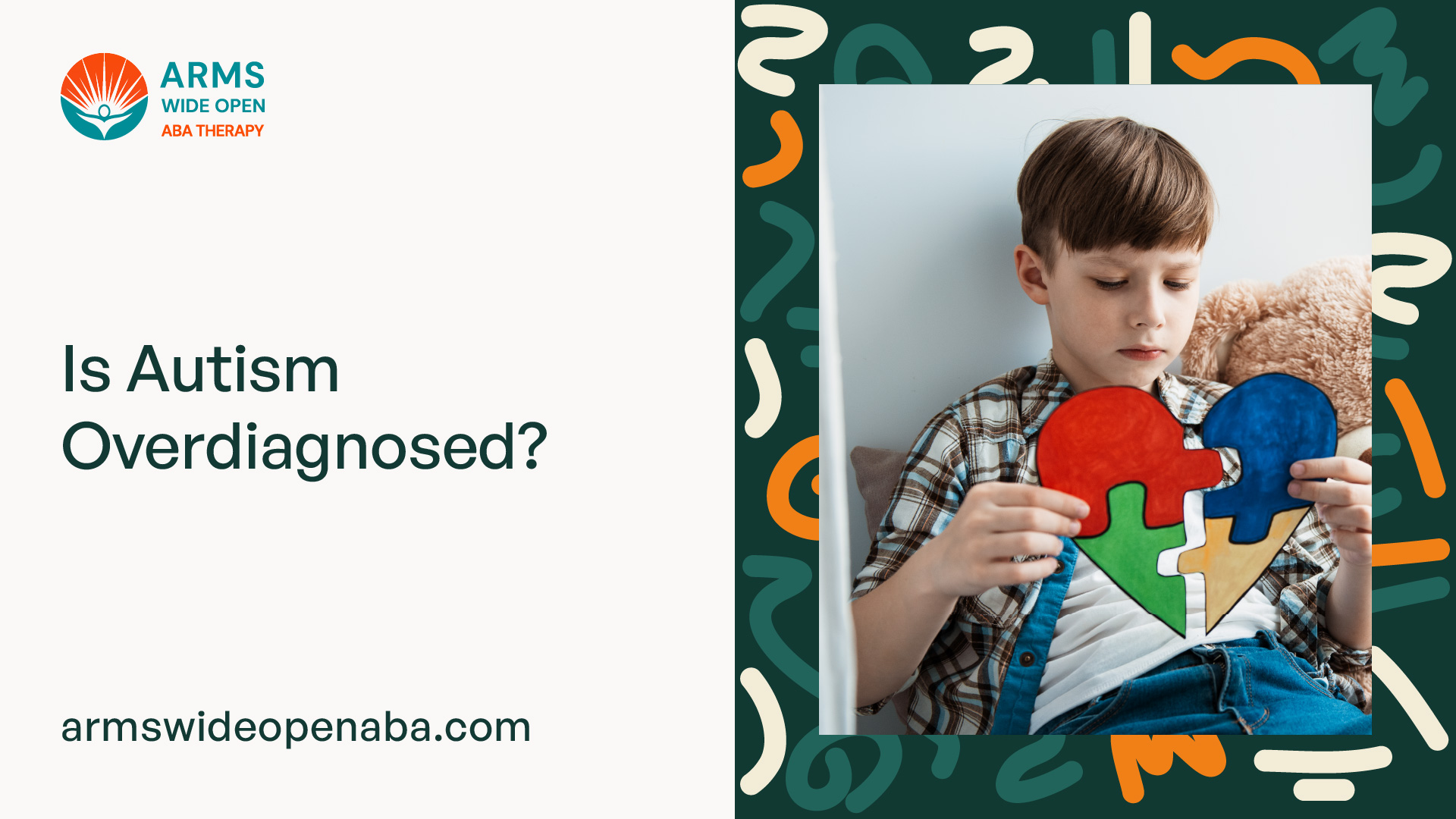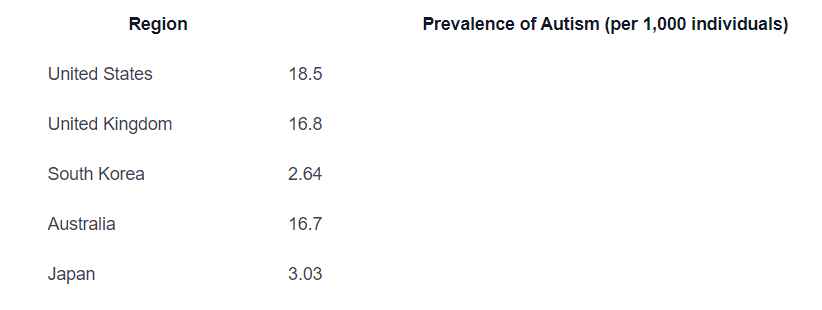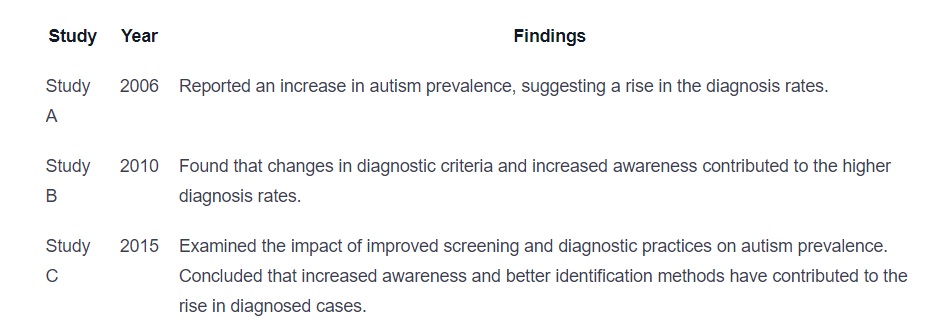Is Autism Overdiagnosed?
Unveiling the truth: Is the autism epidemic a myth or a reality? Explore the overdiagnosis debate and societal impact.

Understanding Autism
Autism Spectrum Disorder (ASD) is a complex developmental disorder that affects individuals across various aspects of their lives. To gain insight into the topic, it is important to understand the definition of ASD and its prevalence.
Definition of Autism Spectrum Disorder
Autism Spectrum Disorder refers to a range of neurodevelopmental conditions that impact an individual's social interaction, communication skills, and behavior. People with ASD may exhibit repetitive behaviors, difficulties with social interactions, and challenges with verbal and nonverbal communication.

ASD is commonly referred to as a "spectrum" disorder because it encompasses a wide range of symptoms and functional abilities. Individuals with ASD may have varying levels of support needs, with some being highly independent and others requiring more assistance in their daily lives.
Prevalence of Autism
The prevalence of autism has been a topic of much discussion and research. It is important to note that while there has been an increase in the number of autism diagnoses in recent years, this does not necessarily indicate an epidemic. Rather, it reflects improvements in diagnostic criteria, increased awareness, and better access to healthcare services.
To provide a clearer perspective on the prevalence of autism, let's take a look at some statistics:

These numbers highlight the variation in autism prevalence across different regions. It is important to consider that these figures represent estimates and may vary based on the methodology used in data collection.
Understanding the definition of autism spectrum disorder and its prevalence is crucial in dispelling misconceptions and promoting a better understanding of the condition. By increasing awareness, we can work towards creating a more inclusive society that supports and empowers individuals with autism.
Overdiagnosis Debate
The topic of overdiagnosis in the context of autism spectrum disorder (ASD) is a subject of ongoing debate. Some argue that there has been a significant increase in the number of autism diagnoses, suggesting overdiagnosis as a contributing factor. However, others maintain that the rise in autism prevalence is a result of improved awareness and diagnostic criteria. Let's explore the factors contributing to the overdiagnosis debate and the arguments against overdiagnosis.
Factors Contributing to Overdiagnosis
Several factors have been identified as potential contributors to the overdiagnosis of autism:
- Expanded Diagnostic Criteria: The expansion of the diagnostic criteria for ASD has broadened the range of behaviors and characteristics that qualify for a diagnosis. This change has led to an increase in the number of individuals meeting the criteria for ASD.
- Increased Awareness and Screening: Greater awareness of autism and increased efforts in screening and early intervention have led to more individuals being identified and diagnosed with autism. This increased focus on early detection may contribute to the perception of higher prevalence rates.
- Diagnostic Substitution: Some argue that the rise in autism diagnoses may be partially due to the reclassification of individuals who would have previously been diagnosed with other conditions, such as intellectual disability or language disorders, into the autism spectrum.
- Societal and Parental Expectations: The pressure to conform to societal and parental expectations for typical development may lead to a greater likelihood of seeking a diagnosis of autism. This pressure may result in a higher number of individuals being diagnosed with ASD, even if their symptoms fall within the normal range of human behavior.
Arguments Against Overdiagnosis
While overdiagnosis is a topic of concern, there are arguments against the notion that autism is being significantly overdiagnosed:
- Improved Diagnostic Tools: The development of more refined diagnostic tools, such as standardized assessment measures and screening questionnaires, has improved the accuracy of autism diagnoses. These tools help to ensure that individuals are accurately identified and receive appropriate support.
- Consistent Prevalence Across Demographics: Studies have shown that the prevalence of autism is relatively consistent across different populations and ethnicities. This suggests that the increase in autism diagnoses is not solely due to overdiagnosis but reflects a true increase in the prevalence of the disorder.
- Longitudinal Studies: Longitudinal studies that track individuals over time have provided evidence supporting the stability of autism diagnoses. These studies demonstrate that the diagnosis of autism in childhood often persists into adolescence and adulthood, further supporting the validity of the diagnoses.
- Global Perspective: Autism diagnoses have shown a similar upward trend in various countries around the world. This global perspective suggests that the increase in autism prevalence is not limited to specific regions or healthcare systems, further challenging the notion of overdiagnosis.
It is important to approach the overdiagnosis debate with caution, considering the complexities involved in accurately diagnosing autism. Ongoing research, improved diagnostic tools, and a better understanding of the condition will continue to shape our understanding of autism and help distinguish between genuine cases and potential overdiagnosis.
Diagnostic Criteria
In order to better understand the topic of autism overdiagnosis, it is essential to explore the diagnostic criteria for autism spectrum disorder (ASD). The diagnostic criteria have evolved over time, leading to changes in how autism is diagnosed and creating challenges in accurately identifying individuals with autism.
Changes in Diagnostic Criteria Over Time
The diagnostic criteria for autism have undergone significant changes over the years. In the past, the diagnostic criteria were narrower and focused primarily on individuals with severe impairments in social communication and repetitive behaviors. However, with advancing research and a better understanding of autism, the diagnostic criteria have expanded to encompass a broader range of individuals on the autism spectrum.
The most notable change came in 2013 with the publication of the Diagnostic and Statistical Manual of Mental Disorders, Fifth Edition (DSM-5). The DSM-5 combined several previously separate diagnoses (such as autistic disorder, Asperger's syndrome, and pervasive developmental disorder-not otherwise specified) into a single diagnosis of ASD. This change aimed to provide a more comprehensive and inclusive framework for diagnosing autism.
By broadening the criteria, the DSM-5 enabled more individuals to meet the diagnostic threshold for autism. This expansion, coupled with increased awareness and improved assessment tools, has contributed to the perception of a rise in autism prevalence.
Challenges in Diagnosing Autism
Diagnosing autism can be complex and challenging. There are several factors that contribute to the difficulties in accurately identifying individuals with autism:
- Heterogeneity of Symptoms: Autism is a spectrum disorder, which means that individuals with autism can present with a wide range of symptoms and varying degrees of severity. This heterogeneity makes it challenging to establish clear-cut diagnostic criteria that capture the diversity of the disorder.
- Overlap with Other Conditions: Autism shares certain features and symptoms with other developmental and psychiatric disorders. This overlap can lead to misdiagnosis or confusion, particularly in cases where individuals exhibit symptoms that align with multiple conditions.
- Developmental Variability: The presentation of autism symptoms can change over time as individuals develop and acquire new skills. This developmental variability can make it difficult to establish a definitive diagnosis, especially in young children who may not exhibit all the characteristic features of autism at the time of assessment.
- Cultural and Societal Influences: Cultural and societal factors can influence perceptions and expectations regarding typical behavior. This can impact how autism is recognized and diagnosed, leading to variations in diagnostic rates across different populations and regions.
- Access to Evaluation and Services: Disparities in access to comprehensive evaluations and specialized services can impact the accuracy of autism diagnoses. Limited access to qualified professionals and resources can result in underdiagnosis or misdiagnosis, particularly in underserved communities.
The challenges in diagnosing autism emphasize the importance of using standardized assessment tools, conducting thorough evaluations, and involving multidisciplinary teams to ensure accurate and comprehensive diagnoses. Ongoing research and collaboration within the field of autism continue to enhance our understanding of the disorder and improve diagnostic practices.
Societal Impact
The perceived increase in autism cases has had significant effects on society. It has sparked debates, raised awareness, and influenced the availability of support and resources for individuals with autism and their families.
Effects of Perceived Increase in Autism Cases
The perception of an autism epidemic, whether real or not, has had both positive and negative effects on society. On one hand, it has led to increased awareness and understanding of autism spectrum disorder (ASD). More people are now familiar with the characteristics and challenges faced by individuals on the spectrum. This increased awareness has helped reduce stigma and promote acceptance.
However, the perception of an autism epidemic has also fueled anxiety and misinformation. Some individuals and communities may become overly concerned about the prevalence of autism, leading to unnecessary fear and discrimination. The focus on autism has also shifted attention and resources away from other important areas of healthcare and education.
Support and Resources for Individuals with Autism
As awareness and understanding of autism have grown, so too have the support and resources available for individuals on the spectrum and their families. Schools, healthcare providers, and communities have increasingly recognized the importance of providing appropriate services and accommodations for individuals with autism.
Support for individuals with autism may include:
- Special education programs: Schools are now better equipped to provide inclusive and individualized education for students with autism. These programs may include tailored learning plans, behavioral support, and access to therapists and specialists.
- Therapies and interventions: Various therapies, such as applied behavior analysis (ABA), speech therapy, occupational therapy, and social skills training, are available to help individuals with autism develop communication, social, and life skills.
- Support networks and organizations: Numerous support groups and organizations exist to provide resources, information, and a sense of community for individuals with autism and their families. These networks offer guidance, advocacy, and opportunities for individuals to connect with others facing similar challenges.
- Legislation and policies: Many countries have implemented laws and policies to protect the rights of individuals with disabilities, including autism. These regulations ensure access to education, employment, healthcare, and other essential services.
Providing adequate support and resources is essential to help individuals with autism thrive and reach their full potential. Continued efforts to improve understanding, promote acceptance, and enhance accessibility will further empower individuals on the autism spectrum and create a more inclusive society.
In the next section, we will explore the research and statistics surrounding autism diagnosis rates to gain a clearer understanding of the prevalence of autism and its potential overdiagnosis.
Research and Statistics
When exploring the topic of autism, it's important to consider the research and statistics surrounding the diagnosis rates and the global perspective on autism.
Studies on Autism Diagnosis Rates
Over the past few decades, there has been a growing interest in studying the diagnosis rates of autism. Researchers have conducted numerous studies to understand the prevalence and trends associated with autism spectrum disorder (ASD). These studies have provided valuable insights into the diagnosis rates and the potential factors contributing to the perceived increase in autism cases.

While these studies indicate an increase in autism diagnosis rates, it's important to note that they do not necessarily imply that autism is overdiagnosed. Rather, they highlight the improved ability to identify and diagnose individuals with ASD.
Global Perspective on Autism
Autism is a global issue that affects individuals across different cultures and countries. The prevalence and awareness of autism can vary among different regions, leading to varying diagnosis rates.

These statistics provide a glimpse into the global perspective on autism. It's important to recognize that these numbers are estimates and can vary based on the methodologies used in different studies. Additionally, cultural factors, access to healthcare, and awareness levels can influence the diagnosis rates in different regions.
By considering research studies and the global perspective on autism, we can gain a better understanding of the diagnosis rates and the varying prevalence of autism across different populations. It is crucial to approach these statistics with an open mind, recognizing the importance of accurate diagnosis and support for individuals with autism spectrum disorder.
Moving Forward
As the understanding of autism spectrum disorder (ASD) continues to evolve, it is crucial to focus on moving forward and taking necessary steps to promote awareness, understanding, and address the stigma and misconceptions surrounding autism.
Promoting Awareness and Understanding
Raising awareness about autism is essential in fostering a more inclusive and supportive society. By increasing public knowledge and understanding about the challenges faced by individuals with autism, we can create a more empathetic and accommodating environment.
One effective way to promote awareness is through educational campaigns and initiatives. These efforts can target various audiences, including schools, workplaces, healthcare professionals, and the general public. Providing accurate information about autism, its characteristics, and the experiences of individuals with autism can help dispel myths and misconceptions.
Furthermore, promoting understanding involves encouraging acceptance and embracing neurodiversity. Recognizing and appreciating the unique strengths and abilities of individuals with autism can contribute to a more inclusive society. By creating opportunities for open dialogue and engaging in respectful conversations, we can foster a supportive environment that celebrates diversity.
Addressing Stigma and Misconceptions
Stigma and misconceptions about autism can have detrimental effects on individuals with autism and their families. It is vital to address these issues to ensure that individuals with autism are not marginalized or excluded from society.
One way to combat stigma is through advocacy and storytelling. Sharing personal stories and experiences can help challenge stereotypes and humanize the condition. By highlighting the achievements and contributions of individuals with autism, we can reshape public perceptions and promote acceptance.
Additionally, providing support and resources for individuals with autism and their families is crucial. Accessible and affordable services, such as therapy, educational programs, and community support groups, can make a significant difference in the lives of those affected by autism. By investing in these resources, we can empower individuals with autism to reach their full potential and lead fulfilling lives.
Addressing stigma and misconceptions requires collaboration among various stakeholders, including policymakers, healthcare professionals, educators, and the media. By working together, we can create a society that embraces and supports individuals with autism, ensuring equal opportunities and a better quality of life for all.
Moving forward, it is essential to continue advancing our knowledge of autism, advocating for inclusive practices, and fostering a society that celebrates and supports individuals with autism. Through ongoing efforts to promote awareness, understanding, and address stigma, we can create a more inclusive world for everyone.
Sources
https://www.abtaba.com/blog/autism-overdiagnosed
https://acamh.onlinelibrary.wiley.com/doi/full/10.1111/jcpp.13806
https://www.autismparentingmagazine.com/autism-spectrum-overdiagnosed/
Similar articles
We’re here to help you

Our team is here to assist you in this process. Contact us for any assistance.
it’s easy to apply
We Accept Most Insurances
Our in-network insurance partnerships make ABA therapy more accessible to families throughout our service areas.







Our Insurance Process
We'll request your insurance details to help us verify your plan's coverage for ABA therapy. Once we've received this information, we'll walk you through your benefits, including copayments, deductibles and out-of-pocket maximums, so you know what to expect in advance.
Our team will then handle the preauthorization and all the necessary paperwork.
.svg)





















.jpeg)


































.jpeg)




.jpeg)







.jpeg)











.jpeg)
















